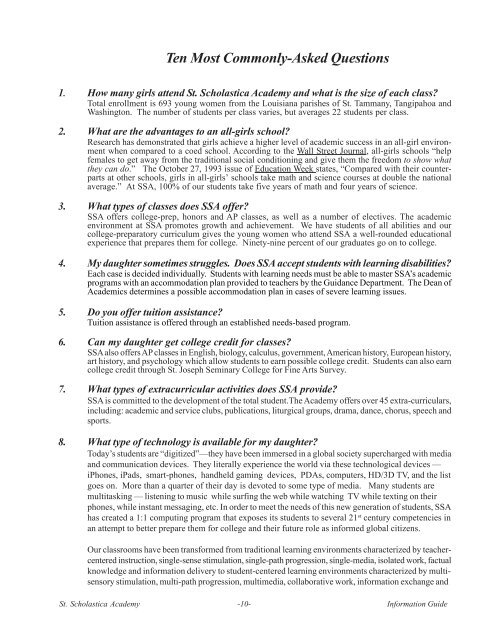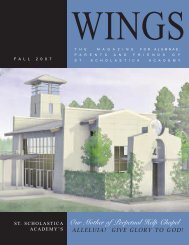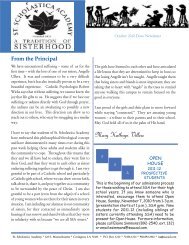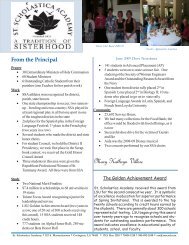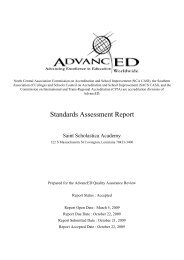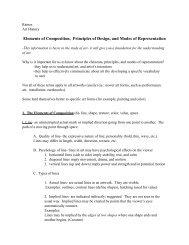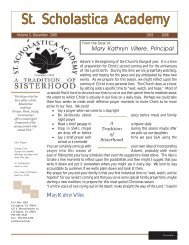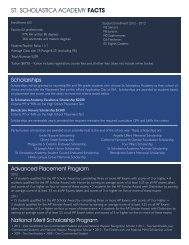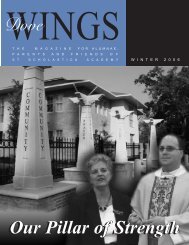Info Guide2012-13 - St. Scholastica Academy
Info Guide2012-13 - St. Scholastica Academy
Info Guide2012-13 - St. Scholastica Academy
Create successful ePaper yourself
Turn your PDF publications into a flip-book with our unique Google optimized e-Paper software.
Ten Most Commonly-Asked Questions<br />
1. How many girls attend <strong>St</strong>. <strong>Scholastica</strong> <strong>Academy</strong> and what is the size of each class<br />
Total enrollment is 693 young women from the Louisiana parishes of <strong>St</strong>. Tammany, Tangipahoa and<br />
Washington. The number of students per class varies, but averages 22 students per class.<br />
2. What are the advantages to an all-girls school<br />
Research has demonstrated that girls achieve a higher level of academic success in an all-girl environment<br />
when compared to a coed school. According to the Wall <strong>St</strong>reet Journal, all-girls schools “help<br />
females to get away from the traditional social conditioning and give them the freedom to show what<br />
they can do.” The October 27, 1993 issue of Education Week states, “Compared with their counterparts<br />
at other schools, girls in all-girls’ schools take math and science courses at double the national<br />
average.” At SSA, 100% of our students take five years of math and four years of science.<br />
3. What types of classes does SSA offer<br />
SSA offers college-prep, honors and AP classes, as well as a number of electives. The academic<br />
environment at SSA promotes growth and achievement. We have students of all abilities and our<br />
college-preparatory curriculum gives the young women who attend SSA a well-rounded educational<br />
experience that prepares them for college. Ninety-nine percent of our graduates go on to college.<br />
4. My daughter sometimes struggles. Does SSA accept students with learning disabilities<br />
Each case is decided individually. <strong>St</strong>udents with learning needs must be able to master SSA’s academic<br />
programs with an accommodation plan provided to teachers by the Guidance Department. The Dean of<br />
Academics determines a possible accommodation plan in cases of severe learning issues.<br />
5. Do you offer tuition assistance<br />
Tuition assistance is offered through an established needs-based program.<br />
6. Can my daughter get college credit for classes<br />
SSA also offers AP classes in English, biology, calculus, government, American history, European history,<br />
art history, and psychology which allow students to earn possible college credit. <strong>St</strong>udents can also earn<br />
college credit through <strong>St</strong>. Joseph Seminary College for Fine Arts Survey.<br />
7. What types of extracurricular activities does SSA provide<br />
SSA is committed to the development of the total student.The <strong>Academy</strong> offers over 45 extra-curriculars,<br />
including: academic and service clubs, publications, liturgical groups, drama, dance, chorus, speech and<br />
sports.<br />
8. What type of technology is available for my daughter<br />
Today’s students are “digitized”—they have been immersed in a global society supercharged with media<br />
and communication devices. They literally experience the world via these technological devices —<br />
iPhones, iPads, smart-phones, handheld gaming devices, PDAs, computers, HD/3D TV, and the list<br />
goes on. More than a quarter of their day is devoted to some type of media. Many students are<br />
multitasking — listening to music while surfing the web while watching TV while texting on their<br />
phones, while instant messaging, etc. In order to meet the needs of this new generation of students, SSA<br />
has created a 1:1 computing program that exposes its students to several 21 st century competencies in<br />
an attempt to better prepare them for college and their future role as informed global citizens.<br />
Our classrooms have been transformed from traditional learning environments characterized by teachercentered<br />
instruction, single-sense stimulation, single-path progression, single-media, isolated work, factual<br />
knowledge and information delivery to student-centered learning environments characterized by multisensory<br />
stimulation, multi-path progression, multimedia, collaborative work, information exchange and<br />
<strong>St</strong>. <strong>Scholastica</strong> <strong>Academy</strong> -10- <strong>Info</strong>rmation Guide


